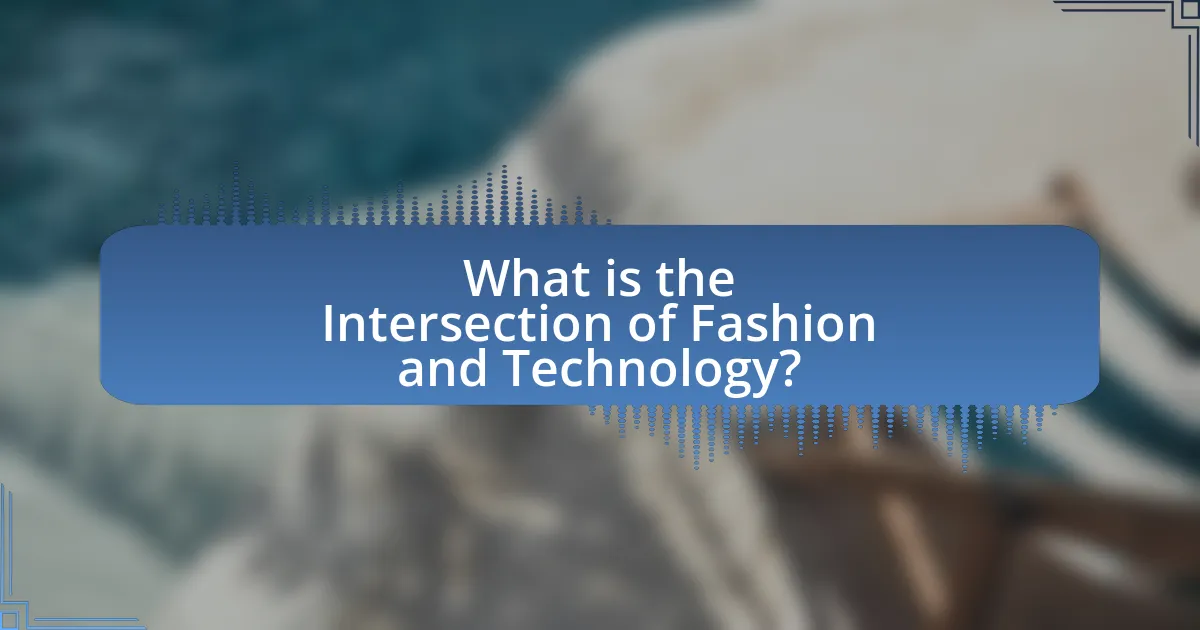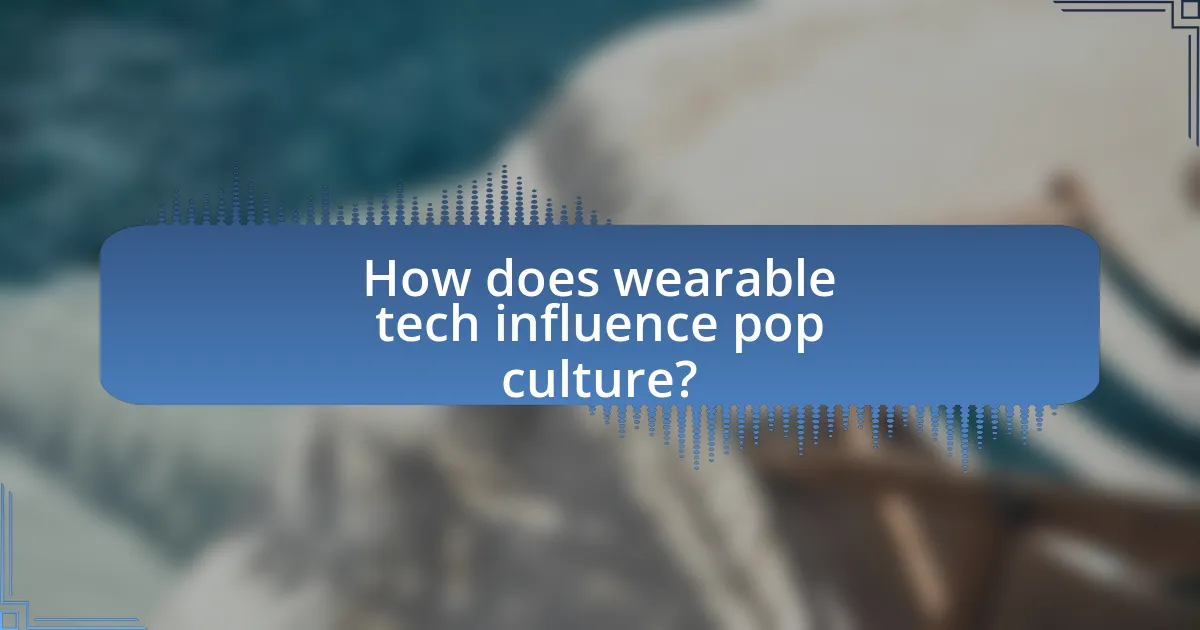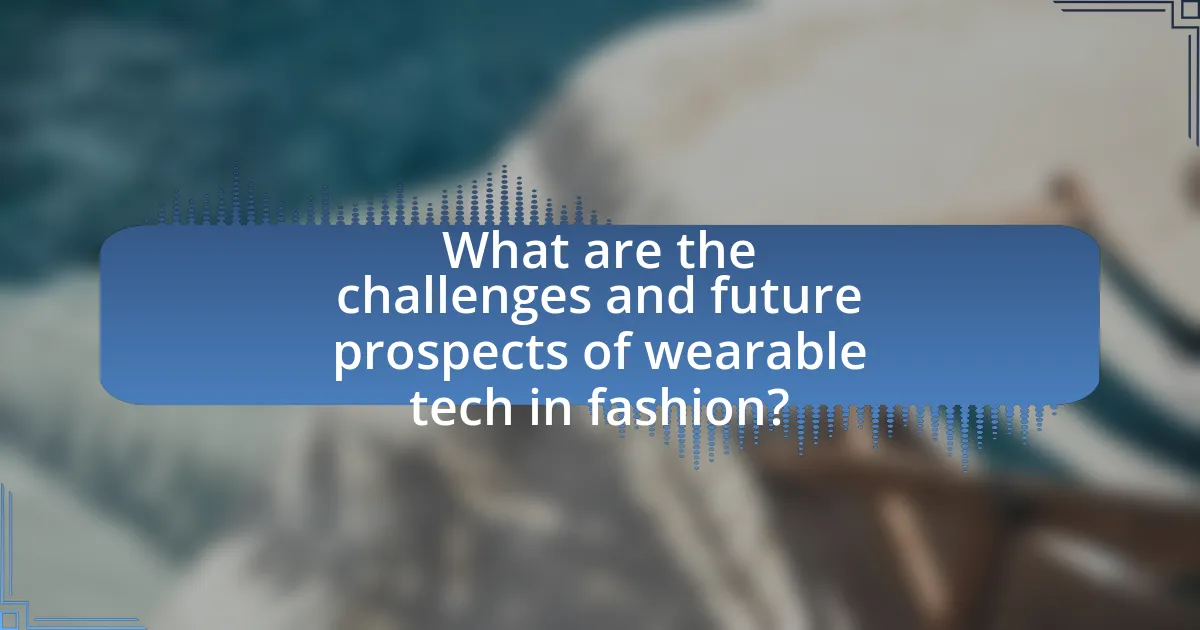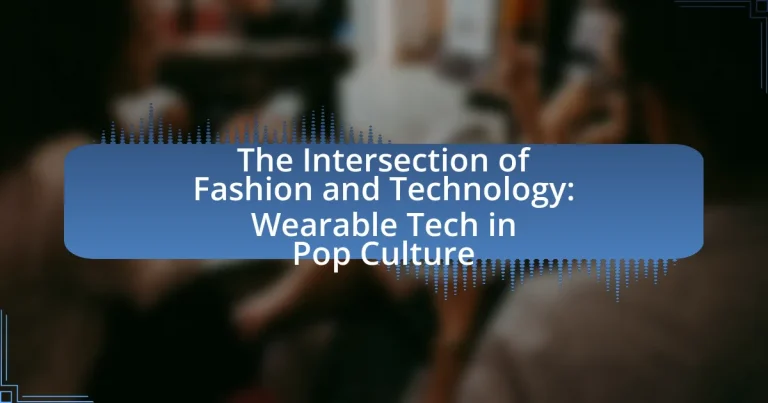The article examines the intersection of fashion and technology, specifically focusing on wearable technology and its impact on pop culture. It outlines the evolution of this relationship, highlighting key historical milestones and cultural shifts that have influenced consumer perceptions and trends. The significance of wearable tech in contemporary fashion is discussed, along with the role of innovation, consumer acceptance, and the challenges faced by designers. Additionally, the article explores how social media and celebrity endorsements shape the popularity of wearable devices, while also addressing sustainability concerns and future prospects in this rapidly evolving sector.

What is the Intersection of Fashion and Technology?
The intersection of fashion and technology refers to the integration of innovative technologies into clothing and accessories, enhancing functionality and aesthetics. This convergence is exemplified by wearable technology, such as smartwatches and fitness trackers, which combine style with health monitoring capabilities. According to a report by Statista, the global wearable technology market is projected to reach $62.82 billion by 2025, indicating significant consumer interest and investment in this area. Additionally, fashion brands are increasingly collaborating with tech companies to create products that not only serve practical purposes but also align with contemporary fashion trends, demonstrating the growing synergy between these two industries.
How has the relationship between fashion and technology evolved over time?
The relationship between fashion and technology has evolved significantly from the early 20th century to the present day, marked by the integration of innovative materials and digital advancements. Initially, fashion was influenced by technological advancements in textile manufacturing, such as the introduction of synthetic fibers like nylon in the 1930s, which revolutionized clothing production and design. As technology progressed, the late 20th century saw the emergence of wearable technology, exemplified by devices like the digital watch in the 1980s, which combined functionality with style.
In the 21st century, the relationship has deepened with the rise of smart textiles and connected devices, such as fitness trackers and smart clothing, which not only serve aesthetic purposes but also enhance user experience through data collection and health monitoring. For instance, the launch of the Apple Watch in 2015 marked a pivotal moment, blending high fashion with advanced technology, influencing both consumer behavior and fashion industry trends. This evolution reflects a growing consumer demand for products that merge style with functionality, showcasing how technology has become an integral part of contemporary fashion culture.
What historical milestones mark the convergence of these two fields?
The historical milestones marking the convergence of fashion and technology include the introduction of the first wearable computer in 1961, known as the “EyeTap,” which allowed users to interact with digital information through a head-mounted display. In 2000, the launch of the first smartwatches, such as the IBM WatchPad, further integrated technology into fashion, enabling users to access information on their wrists. The 2010s saw the rise of fitness trackers like Fitbit, which combined health monitoring with stylish designs, making wearable tech mainstream. Additionally, in 2016, the release of smart clothing, such as the Athos workout gear with embedded sensors, showcased the blending of textiles and technology. These milestones illustrate the ongoing evolution and integration of technology within the fashion industry.
How have cultural shifts influenced this intersection?
Cultural shifts have significantly influenced the intersection of fashion and technology, particularly in the realm of wearable tech in pop culture. The rise of digital connectivity and social media has transformed consumer expectations, leading to a demand for innovative, stylish, and functional wearable devices. For instance, the popularity of fitness trackers and smartwatches reflects a cultural emphasis on health and wellness, with a 2020 report indicating that the global wearable technology market was valued at approximately $32 billion, driven by consumer interest in health monitoring. Additionally, collaborations between fashion designers and tech companies, such as the partnership between Apple and Hermès for the Apple Watch, illustrate how cultural trends prioritize luxury and personalization in technology, further blurring the lines between fashion and functionality.
Why is wearable technology significant in contemporary fashion?
Wearable technology is significant in contemporary fashion because it merges functionality with style, enhancing user experience while promoting personal expression. This integration allows consumers to track health metrics, receive notifications, and interact with their environment seamlessly, all while wearing aesthetically pleasing items. For instance, the global market for wearable technology is projected to reach $60 billion by 2023, indicating a growing consumer demand for devices that blend into everyday attire. Additionally, brands like Apple and Fitbit have successfully incorporated fashion elements into their products, demonstrating that technology can be both practical and fashionable.
What role does innovation play in the fashion industry?
Innovation is crucial in the fashion industry as it drives creativity, efficiency, and sustainability. The integration of technology, such as 3D printing and smart textiles, allows designers to create unique products while reducing waste. For instance, brands like Adidas have utilized 3D printing to produce shoes with minimal material usage, showcasing how innovation can lead to both environmental benefits and enhanced consumer experiences. Furthermore, wearable technology, such as fitness trackers and smartwatches, has transformed how consumers interact with fashion, merging functionality with style. This evolution highlights the importance of innovation in meeting changing consumer demands and advancing industry standards.
How do consumers perceive wearable tech in fashion?
Consumers perceive wearable tech in fashion as a blend of functionality and style, appreciating its ability to enhance personal expression while providing practical benefits. A survey conducted by McKinsey & Company in 2021 revealed that 70% of consumers are interested in wearable technology that integrates seamlessly into their daily lives, indicating a strong demand for stylish yet functional designs. Additionally, the rise of smartwatches and fitness trackers has shown that consumers value the convenience of health monitoring and connectivity, with the global wearable technology market projected to reach $60 billion by 2023, further underscoring the positive perception of wearable tech in the fashion industry.
What are the key types of wearable technology in fashion?
The key types of wearable technology in fashion include smartwatches, fitness trackers, smart clothing, augmented reality glasses, and smart jewelry. Smartwatches, such as the Apple Watch, integrate health monitoring and notifications, while fitness trackers like Fitbit focus on activity and health metrics. Smart clothing incorporates sensors for tracking biometrics, exemplified by brands like Athos. Augmented reality glasses, such as Google Glass, enhance user experience through digital overlays, and smart jewelry, like Ringly, combines aesthetics with functionality by providing notifications. These technologies reflect the growing trend of merging functionality with fashion, as evidenced by the increasing market demand for wearable tech, projected to reach $60 billion by 2023 according to Statista.
What are the most popular wearable tech devices currently available?
The most popular wearable tech devices currently available include smartwatches, fitness trackers, and smart glasses. Smartwatches like the Apple Watch Series 8 and Samsung Galaxy Watch 5 dominate the market, offering features such as health monitoring, notifications, and app integration. Fitness trackers, such as the Fitbit Charge 5 and Garmin Venu Sq, are favored for their focus on health metrics and activity tracking. Smart glasses, notably the Ray-Ban Stories and Google Glass, are gaining traction for their ability to integrate augmented reality and hands-free functionality. These devices reflect a growing trend in consumer technology, with the global wearable technology market projected to reach $60 billion by 2023, highlighting their popularity and relevance in everyday life.
How do these devices integrate with everyday fashion choices?
Wearable devices integrate with everyday fashion choices by combining functionality with style, allowing users to express personal aesthetics while benefiting from technology. For instance, smartwatches and fitness trackers are designed to complement various outfits, featuring customizable bands and sleek designs that appeal to fashion-conscious consumers. According to a report by McKinsey & Company, the global market for wearable technology is projected to reach $62 billion by 2025, indicating a growing trend where consumers prioritize both utility and fashion in their tech accessories. This integration is further evidenced by collaborations between tech companies and fashion brands, such as the partnership between Apple and Hermès, which showcases how technology can enhance fashion without compromising on style.

How does wearable tech influence pop culture?
Wearable tech significantly influences pop culture by integrating technology into everyday fashion, shaping trends and consumer behavior. Devices like smartwatches and fitness trackers have become status symbols, often featured in media and endorsed by celebrities, which drives their popularity. For instance, the Apple Watch’s launch in 2015 not only revolutionized personal technology but also positioned itself as a fashion accessory, leading to collaborations with high-end designers like Hermès. This intersection of functionality and style has led to a cultural shift where technology is not just utilitarian but also a key component of personal expression and identity in contemporary society.
What impact does wearable technology have on celebrity fashion trends?
Wearable technology significantly influences celebrity fashion trends by integrating functionality with style, leading to increased visibility and acceptance of tech-infused apparel. Celebrities often showcase smartwatches, fitness trackers, and augmented reality glasses, which not only enhance their personal brand but also set trends that fans and the fashion industry follow. For instance, when celebrities like Rihanna and Lady Gaga wear innovative tech pieces, it generates media buzz and consumer interest, driving brands to incorporate similar technologies into their collections. This trend is supported by a report from the Global Fashion Agenda, which highlights that 60% of consumers are more likely to purchase products endorsed by celebrities using wearable tech, demonstrating the direct impact on market demand and fashion direction.
How do celebrities use wearable tech to enhance their public image?
Celebrities use wearable tech to enhance their public image by showcasing innovative and fashionable devices that align with their personal brand. For instance, high-profile figures like Rihanna and Kim Kardashian often wear smartwatches and fitness trackers that not only serve functional purposes but also make bold fashion statements. This visibility helps them connect with tech-savvy audiences and reinforces their status as trendsetters. Additionally, collaborations with tech companies, such as Beyoncé’s partnership with Fitbit, further amplify their influence, as these endorsements can lead to increased consumer interest and sales. By integrating wearable technology into their public appearances, celebrities effectively blend style with functionality, enhancing their appeal and relevance in both the fashion and tech industries.
What are some notable examples of wearable tech in celebrity culture?
Notable examples of wearable tech in celebrity culture include the Apple Watch, which has been prominently featured by celebrities like Beyoncé and Drake, showcasing its integration into daily life and fashion. Additionally, smart glasses like Google Glass have been worn by stars such as Lady Gaga, highlighting their potential as a fashion statement. Fitness trackers, such as Fitbit, have been endorsed by celebrities like Khloé Kardashian, emphasizing health and wellness trends. These instances illustrate how wearable technology has become a significant aspect of celebrity lifestyles, merging functionality with style.
How does social media shape the perception of wearable tech in fashion?
Social media significantly shapes the perception of wearable tech in fashion by amplifying visibility and influencing trends. Platforms like Instagram and TikTok allow influencers and brands to showcase innovative wearable tech, creating a narrative that blends functionality with style. For instance, the rise of smartwatches and fitness trackers has been propelled by social media campaigns that highlight their aesthetic appeal alongside their technological benefits. According to a 2021 study by McKinsey & Company, 70% of consumers reported that social media influenced their purchasing decisions in fashion, indicating that the portrayal of wearable tech as fashionable can drive consumer interest and acceptance.
What platforms are most influential in promoting wearable tech trends?
Social media platforms, particularly Instagram, TikTok, and YouTube, are the most influential in promoting wearable tech trends. These platforms enable brands and influencers to showcase wearable technology through visually engaging content, reaching millions of users quickly. For instance, a study by Statista in 2023 indicated that 67% of consumers discover new tech products through social media, highlighting its role in shaping consumer preferences. Additionally, influencer partnerships on these platforms often lead to increased brand visibility and consumer interest, further solidifying their impact on wearable tech trends.
How do influencers contribute to the popularity of wearable technology?
Influencers significantly contribute to the popularity of wearable technology by showcasing these products to their large audiences, thereby driving consumer interest and adoption. Their endorsements often highlight the functionality, style, and lifestyle integration of wearables, making them more appealing to potential buyers. For instance, a study by the Digital Marketing Institute found that 49% of consumers rely on influencer recommendations when making purchase decisions, indicating the substantial impact influencers have on consumer behavior. Additionally, influencers often create engaging content that demonstrates how wearable technology can enhance daily life, further solidifying its desirability in the fashion and tech intersection.

What are the challenges and future prospects of wearable tech in fashion?
The challenges of wearable tech in fashion include issues related to comfort, battery life, and integration with existing fashion trends. Wearable devices often face criticism for being bulky or uncomfortable, which can deter consumers from adopting them. Additionally, limited battery life can hinder functionality, as users may need to frequently recharge devices. Integration with fashion trends poses another challenge, as wearable tech must align with aesthetic preferences to appeal to consumers.
Future prospects for wearable tech in fashion are promising, with advancements in materials and design likely to enhance user experience. Innovations such as flexible electronics and smart textiles are being developed, which can lead to more comfortable and stylish wearable devices. The global wearable technology market is projected to grow significantly, with estimates suggesting it could reach $60 billion by 2023, indicating strong consumer interest and investment in this sector.
What obstacles do designers face when integrating technology into fashion?
Designers face several obstacles when integrating technology into fashion, primarily including technical limitations, high production costs, and consumer acceptance. Technical limitations arise from the challenges of creating functional yet aesthetically pleasing wearable tech, as many devices are bulky or uncomfortable. High production costs can deter designers from experimenting with advanced materials and technologies, as the investment may not guarantee a return. Additionally, consumer acceptance is a significant hurdle; many consumers are hesitant to adopt wearable tech due to concerns about usability, privacy, and style. These factors collectively hinder the seamless integration of technology into fashion, impacting the overall success of innovative designs.
How do issues of privacy and data security affect consumer acceptance?
Issues of privacy and data security significantly impact consumer acceptance of wearable technology. Consumers are increasingly concerned about how their personal data is collected, stored, and used by wearable devices, leading to hesitance in adopting such technologies. For instance, a survey by Pew Research Center found that 79% of Americans are concerned about how companies use their data, which directly correlates with their willingness to embrace new tech products. When consumers perceive a lack of transparency or inadequate security measures, their trust diminishes, resulting in lower acceptance rates of wearable tech.
What are the sustainability concerns related to wearable tech?
Sustainability concerns related to wearable tech include electronic waste, resource depletion, and energy consumption. The rapid turnover of devices contributes to significant electronic waste, with an estimated 53.6 million metric tons generated globally in 2019, according to the Global E-waste Monitor. Additionally, the production of wearable devices often requires rare materials, leading to resource depletion and environmental degradation. Energy consumption during manufacturing and usage also raises concerns, as many wearables rely on batteries that require substantial energy to produce and dispose of. These factors collectively highlight the environmental impact of wearable technology in the context of sustainability.
What innovations can we expect in the future of wearable technology in fashion?
Future innovations in wearable technology in fashion will likely include advanced smart textiles, augmented reality integration, and enhanced biometric monitoring. Smart textiles will enable garments to change color or pattern based on environmental conditions or user preferences, as demonstrated by companies like Chromat and their use of responsive fabrics. Augmented reality will allow users to visualize clothing in virtual environments before purchase, enhancing the shopping experience, as seen in applications like IKEA Place. Enhanced biometric monitoring will provide real-time health data through clothing, with brands like Under Armour already incorporating sensors into their apparel to track fitness metrics. These advancements will redefine how consumers interact with fashion, merging functionality with style.
How might advancements in technology change the design of wearable items?
Advancements in technology will significantly enhance the design of wearable items by integrating smart functionalities and improving materials. For instance, the incorporation of flexible electronics allows for the creation of garments that can monitor health metrics, such as heart rate and temperature, without sacrificing comfort or style. Additionally, innovations in fabric technology, such as moisture-wicking and self-cleaning materials, will lead to more functional and durable wearables. Research from the Journal of Fashion Technology & Textile Engineering indicates that the global smart clothing market is projected to reach $5.3 billion by 2024, highlighting the growing demand for technologically advanced wearable items.
What trends are emerging in the intersection of fashion and technology?
Emerging trends at the intersection of fashion and technology include the rise of smart textiles, augmented reality (AR) in retail, and the integration of artificial intelligence (AI) in design processes. Smart textiles, such as those that change color or monitor health metrics, are gaining popularity, with companies like Nike and Under Armour investing in this technology. Augmented reality is transforming the shopping experience, allowing consumers to virtually try on clothes through apps like Zara’s AR feature. Additionally, AI is increasingly used in fashion design, with algorithms predicting trends and assisting designers, as seen with brands like Stitch Fix utilizing data analytics to tailor offerings. These trends reflect a growing synergy between fashion and technology, enhancing consumer engagement and product functionality.
What practical tips can consumers consider when choosing wearable tech in fashion?
Consumers should prioritize functionality, style, and compatibility when choosing wearable tech in fashion. Functionality ensures that the device meets specific needs, such as fitness tracking or notifications, while style guarantees that it complements personal aesthetics. Compatibility with existing devices, like smartphones, is crucial for seamless integration and usability. According to a 2022 survey by Statista, 45% of consumers consider design as a key factor in their purchasing decisions for wearable technology, highlighting the importance of aesthetics in the fashion-tech intersection.
How can consumers select wearable tech that complements their style?
Consumers can select wearable tech that complements their style by considering design aesthetics, functionality, and personal preferences. The design should align with their wardrobe and lifestyle, ensuring that the wearable tech enhances rather than detracts from their overall look. Functionality is also crucial; consumers should choose devices that not only fit their style but also meet their specific needs, such as fitness tracking or notifications. Personal preferences, including color, material, and brand reputation, further influence the selection process. Research indicates that 70% of consumers prioritize style when purchasing wearable technology, demonstrating the importance of aesthetic appeal in their decision-making.
What should consumers look for in terms of functionality and design?
Consumers should prioritize user-friendliness and aesthetic appeal when evaluating wearable tech. User-friendliness ensures that the device is intuitive and easy to operate, which is crucial for enhancing the overall experience. Aesthetic appeal is equally important, as consumers often seek products that complement their personal style and fit seamlessly into their daily lives. For instance, a study by the Consumer Technology Association found that 70% of consumers consider design a key factor in their purchasing decisions for wearable technology. This highlights the significance of both functionality and design in influencing consumer choices in the wearable tech market.


